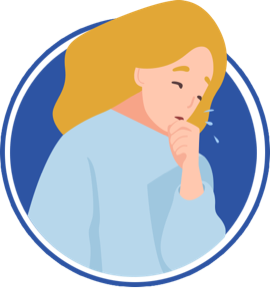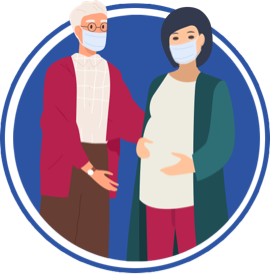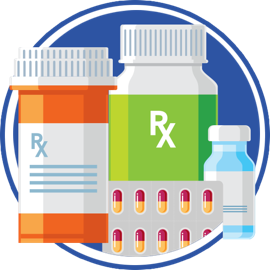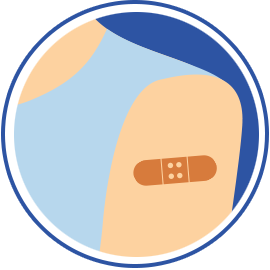 |
|---|
หน้าหลัก | สุขภาพดี | สุภาพสตรี | การแปลผลเลือด | โรคต่างๆ | วัคซีน
New coronavirus vs. flu
The symptoms section of this article was updated on May 19, 2020.
COVID-19 and the flu can cause similar symptoms. However, there are several differences between them.
The novel strain of coronavirus (SARS-CoV-2) causes coronavirus disease 19 (COVID-19).
Both COVID-19 and the flu are respiratory illnesses that spread from person to person. This article will discuss the differences between COVID-19 and the flu.
Stay informed with live updates on the current COVID-19 outbreak and visit our coronavirus hub for more advice on prevention and treatment.
The symptoms of the flu and COVID-19 have some differences.
People who have the flu will typically experience symptoms within 1–4 daysTrusted Source . The symptoms for COVID-19 can develop between 1–14 daysTrusted Source . However, according to 2020 research, the median incubation period for COVID-19 is 5.1 daysTrusted Source .
As a point of comparison, the incubation period for a cold is 1–3 days.
The symptoms of COVID-19 are similar in both children and adults. However, according to the Centers for Disease Control and Prevention (CDC)Trusted Source , children typically present with fever and mild, cold-like symptoms, such as a runny nose and a cough.
The following table outlines the symptoms of COVID-19, the flu, and a cold.
The symptoms of COVID-19 and flu can range from mild to severe. Both can also cause pneumonia.
It is important to note that the World Health Organization (WHO) have classified mild symptoms of COVID-19 to mean that a person will not require hospitalization. The WHO classify mild cases to consist of symptoms including:
The CDCTrusted Source also lists the following as potential symptoms:
According to the WHOTrusted Source , around 15% of COVID-19 cases are severe, and 5% are critical. Those in a critical state require a ventilator to breathe. The chance of severe and critical infection is higher with COVID-19 than the flu.
COVID-19 is also more deadly. According to the WHO, the mortality rate for COVID-19 appears to be higherTrusted Source than that of the flu.
Compared with the flu, research on COVID-19 is still in its early stages. These estimates may change over time.
Both SARS-CoV-2 and the flu virus can spread through person to person contact.
Tiny droplets containing the viruses can pass from someone with the infection to someone else, typically through the nose and mouth through coughing and sneezing.
The virus can also live on surfaces. The WHOTrusted Source is not sure exactly how long the virus can survive, but it could be days.
According to the CDC, people can transmit the flu virus to people who are 6 feet (ft)Trusted Source away. According to the WHO, people should stay at least 6 ftTrusted Source away from anyone coughing or sneezing to help prevent the transmission of the SARS-CoV-2 infection.
According to the WHOTrusted Source , the speed of transmission differs between the two viruses. The symptoms of flu appear sooner, and it can spread faster than the SARS-CoV-2 virus.
The organization also indicate that people with flu can pass the virus on before they show any symptoms. A person can also pass on the SARS-CoV-2 infection even if they have no symptoms.
There are also differences in transmission between children and adults.
According to the WHOTrusted Source , the transmission of the flu from children to adults is common. However, based on early data it appears that it is more common for adults to pass the SARS-CoV-2 infection onto children. Children are less likely to develop symptoms.
The CDCTrusted Source recommends that people who are not fully vaccinated wear cloth face masks in indoor public settings. If case numbers are high in the area, it may be best to wear a mask outdoors, as well. This will help slow the spread of the virus from people who do not know that they have contracted it, including those who are asymptomatic. Note: It is critical that surgical masks and N95 respirators are reserved for healthcare workers
As flu has been around much longer than COVID-19, there are more treatment options.
Most people with the flu do not require medical treatment. But a doctor might prescribe antiviral drugs in some cases, which can reduce the symptoms by 1–2 daysTrusted Source .
These antiviral drugs help the body fight the virus. They treat symptoms and reduce how long the illness lasts.
There are currently no antiviral drugs approved to treat COVID-19, although scientists are currently researching drugs in trials. When scientists have had more time to study the disease, the availability of antivirals to treat COVID-19 will likely increase.
Although there is currently no approved treatment or vaccination for COVID-19, there are ways to help treat the symptoms and any complications that can occur.
For mild cases, a person should remain home and undertake social distancing. Healthcare professionals may prescribe antipyretics to reduce the fever.
For more severe cases, a person may require supplemental oxygen or mechanical ventilation on a breathing machine to treat the respiratory problems that may occur.
The most effective Trusted Source way of preventing the flu is through vaccination.
Many strains of influenza can cause infection. The most common strains vary depending on the season.
Doctors will try to predict what strains will be most common each season to select the right vaccine components.
There is currently no vaccine available for the SARS-CoV-2 infection. The virus is new, and developing safe vaccines takes time.
The best way to prevent spreading the SARS-CoV-2 virus includes:
Both COVID-19 and the flu are viral infections.
Viruses are tiny microbes that survive by invading other living cells. These cells become host cells to the virus, which multiplies inside of them. They can then spread to new cells around the body.
Coronaviruses are a family of viruses that cause respiratory infections. The SARS-CoV-2 causes the infection that leads to COVID-19.
There are two types of viruses that cause the flu — influenza A and B. There are also several subtypes of influenza A. Any of these viruses can cause the flu.
COVID-19 and flu share some similar symptoms. The symptoms of flu tend to occur faster and can have greater variation. But COVID-19 is more likely to lead to severe illness or death.
Both viruses spread via person to person contact. Flu spreads faster and is more likely to affect children.
As the flu has been around longer, there are several effective antiviral treatments and vaccines available. Researchers and scientists are developing these for COVID-19, but treatments and vaccines are not likely to be available soon.
The best way to prevent COVID-19 is to practice social distancing, which means avoiding any non-essential social contact or travel. It is essential to maintain good personal and domestic hygiene by washing the hands regularly and keeping surfaces and utensils clean.
Viral infections cause both COVID-19 and the flu. But COVID-19 is due to the SARS-CoV-2 virus, and flu is from influenza A and B viruses.
What is the difference between Influenza (Flu) and COVID-19?
Influenza (flu) and COVID-19 are both contagious respiratory illnesses, but they are caused by different viruses. COVID-19 is caused by infection with a coronavirus first identified in 2019, and flu is caused by infection with influenza viruses.
COVID-19 seems to spread more easily than flu. However, as more people become fully vaccinated against COVID-19, the spread of the virus that causes COVID-19 should slow down. More information is available about COVID-19 vaccines and how well they work.
Compared to flu, COVID-19 can cause more serious illnesses in some people. COVID-19 can also take longer before people show symptoms and people can be contagious for longer. More information about differences between flu and COVID-19 is available in the different sections below.
Because some of the symptoms of flu, COVID-19, and other respiratory illnesses are similar, the difference between them cannot be made based on symptoms alone. Testing is needed to tell what the illness is and to confirm a diagnosis. People can be infected with both flu and the virus that causes COVID-19 at the same time and have symptoms of both influenza and COVID-19.
While more is learned every day about COVID-19 and the virus that causes it, there are still things, such as post-COVID conditions, that are unknown. This page compares COVID-19 and flu, given the best available information to date.
How Long Symptoms Appear After Exposure and Infection
Similarities:
For both COVID-19 and flu, 1 or more days can pass between when a person becomes infected and when he or she starts to experience illness symptoms.
Differences:
If a person has COVID-19, it could take them longer to experience symptoms than if they had flu.
Flu
Typically, a person experiences symptoms anywhere from 1 to 4 days after infection.
COVID-19
Typically, a person experiences symptoms about 5 days after being infected, but symptoms can appear 2 to 14 days after infection.

How Long Someone Can Spread the Virus
Similarities:
For both COVID-19 and flu, it’s possible to spread the virus for at least 1 day before experiencing any symptoms.
Differences:
If a person has COVID-19, they could be contagious for a longer time than if they had flu.
Flu
Most people with flu are contagious for about 1 day before they show symptoms.
Older children and adults with flu appear to be most contagious during the initial 3-4 days of their illness but many people remain contagious for about 7 days.
Infants and people with weakened immune systems can be contagious for even longer.
COVID-19
How long someone can spread the virus that causes COVID-19 is still under investigation.
It’s possible for people to spread the virus for about 2 days before experiencing signs or symptoms (or possibly earlier) and remain contagious for at least 10 days after signs or symptoms first appeared. If someone is asymptomatic or their symptoms go away, it’s possible to remain contagious for at least 10 days after testing positive for COVID-19. People who are hospitalized with severe disease and people with weakened immune systems can be contagious for 20 days or longer.

How it Spreads
Similarities:
Both COVID-19 and flu can spread from person-to-person between people who are in close contact with one another (within about 6 feet). Both are spread mainly by large and small particles containing virus that are expelled when people with the illness (COVID-19 or flu) cough, sneeze, or talk. These particles can land in the mouths or noses of people who are nearby and possibly be inhaled into the lungs. In some circumstances, such as indoor settings with poor ventilation, small particles might be spread further than 6 feet and cause infections.
Although most spread is by inhalation, it may be possible that a person can get infected by touching (for example, shaking hands with someone who has the virus on their hands) or by touching a surface or object that has virus on it, and then touching their own mouth, nose, or eyes.
Both flu viruses and the virus that causes COVID-19 can be spread to others by people before they begin showing symptoms; by people with very mild symptoms; and by people who never experience symptoms (asymptomatic people).
Differences:
While the virus that causes COVID-19 and flu viruses are thought to spread in similar ways, the virus that causes COVID-19 is generally more contagious than flu viruses. Also, COVID-19 has been observed to have more superspreading events than flu. This means the virus that causes COVID-19 can quickly and easily spread to a lot of people and result in continual spreading among people as time progresses.

People at Higher-Risk for Severe Illness
Similarities:
Both COVID-19 and flu illness can result in severe illness and complications. Those at highest risk include:
Differences:
Overall, COVID-19 seems to cause more serious illnesses in some people.
Serious COVID-19 illness resulting in hospitalization and death can occur even in healthy people.
Some people that had COVID-19 can go on to develop post-COVD conditions or multisystem inflammatory syndrome (MIS)

Complications
Similarities:
Both COVID-19 and flu can result in complications, including:
Differences:
Flu
Most people who get flu will recover on their own in a few days to two weeks, but some people will experience severe complications, requiring hospitalization. Some of these complications are listed above. Secondary bacterial infections are more common with influenza than with COVID-19.
Diarrhea is more common in young children with flu than in adults with flu.
COVID-19
Additional complications associated with COVID-19 can include:
Long COVID is a range of symptoms that can last weeks or months after first being infected with the virus that causes COVID-19 or can appear weeks after infection. Long COVID can happen to anyone who has had COVID-19, even if their illness was mild, or if they had no symptoms.

Approved Treatments
Similarities:
People at higher risk of complications or who have been hospitalized for COVID-19 or flu should receive supportive medical care to help relieve symptoms and complications.
Differences:
Flu
Prescription influenza antiviral drugs are FDA-approved to treat flu.
People who are hospitalized with flu or who are at increased risk of complications and have flu symptoms are recommended to be treated with antiviral drugs as soon as possible after illness onset.
COVID-19
The National Institutes of Health (NIH) has developed guidance on treatment of COVID-19external icon, which is regularly updated as new evidence on treatment options emerges.
The Food and Drug Administration (FDA) has approved one drug, remdesivir (Veklury®), to treat COVID-19. FDA has issued emergency use authorizationsexternal icon (EUAs) to allow healthcare providers to use investigational products that are not yet approved, or that are approved for other uses, to treat patients with COVID-19 if certain legal requirements are metexternal icon.

Vaccine
Similarities:
Vaccines for COVID-19 and flu are approved and/or authorized for emergency use (EUA) by FDA.
Differences:
Flu
There are multiple FDA-licensed influenza vaccines produced annually to protect against the 4 flu viruses that scientists expect will circulate each year.
COVID-19
Three COVID-19 vaccines have been authorized for use by FDA under an EUA. Other vaccines to prevent COVID-19 are under development.

COVID-19 vs. flu: Similarities and differences
COVID-19 (coronavirus) and the flu have many similarities and differences. Find out what to know and how to protect yourself from these diseases.
By Mayo Clinic StaffDuring the COVID-19 pandemic, you may have heard that coronavirus disease 2019 (COVID-19) is similar to the flu (influenza). COVID-19 and the flu are both contagious respiratory diseases caused by viruses. They have some common symptoms. But through closer comparison, they can affect people differently. Also, since the flu has been around much longer, doctors know more about how to treat and prevent it, while they continue to learn more about COVID-19.
How are COVID-19 and the flu similar?
How COVID-19 and flu spread
The viruses that cause COVID-19 and the flu spread in similar ways. They can both spread between people who are in close contact (within 6 feet, or 2 meters). The viruses spread through respiratory droplets or aerosols released through talking, sneezing or coughing. These droplets can land in the mouth or nose of someone nearby or be inhaled. These viruses can also spread if a person touches a surface with one of the viruses on it and then touches his or her mouth, nose, or eyes.
COVID-19 and flu symptoms
COVID-19 and the flu have many signs and symptoms in common, including:
The signs and symptoms of both diseases can range from no symptoms to mild or severe symptoms. Because COVID-19 and the flu have similar symptoms, it can be hard to diagnose which condition you have based on your symptoms alone. Testing may be done to see if you have COVID-19 or the flu. You can also have both diseases at the same time.
COVID-19 and flu complications
Both COVID-19 and the flu can lead to serious complications, such as:
Many people with the flu or mild symptoms of COVID-19 can recover at home with rest and fluids. But some people become seriously ill from the flu or COVID-19 and need to stay in the hospital.
What's the difference between COVID-19 and the flu?
COVID-19 and the flu have several differences, including different causes, complications and treatments. COVID-19 and the flu also spread differently, have different severity levels and a few different symptoms, and can be prevented by different vaccines.
COVID-19 and flu causes
COVID-19 and the flu have several differences. COVID-19 and the flu are caused by different viruses. COVID-19 is caused by a new coronavirus called SARS-CoV-2, while influenza is caused by influenza A and B viruses.
COVID-19 and flu symptoms
Symptoms of COVID-19 and the flu appear at different times and have some differences. COVID-19 symptoms generally appear 2-14 days after exposure. Flu symptoms usually appear about 1-4 days after exposure.
COVID-19 and flu spread and severity
COVID-19 appears to be more contagious and to spread more quickly than the flu. With COVID-19, you may experience loss of taste or smell. Severe illness such as lung injury is more frequent with COVID-19 than with influenza. The mortality rate also is higher with COVID-19 than the flu.
So far, more than 38 million people have had COVID-19 in the U.S. as reported by the Centers for Disease Control and Prevention (CDC). More than 630,000 people have died of COVID-19 in the U.S. in 2020 and 2021.
By comparison, during the 2019-2020 flu season in the U.S., about 38 million people had the flu and about 22,000 people died of the flu.
COVID-19 and flu complications
COVID-19 can cause different complications from the flu, such as blood clots and multisystem inflammatory syndrome in children.
COVID-19 and flu treatments
Another difference is that the flu can be treated with antiviral drugs. Only one antiviral drug, called remdesivir, is currently approved to treat COVID-19. Researchers are evaluating many drugs and treatments for COVID-19. Some drugs may help reduce the severity of COVID-19.
COVID-19 and flu prevention
You can get an annual flu vaccine to help reduce your risk of the flu. The flu vaccine can also reduce the severity of the flu and the risk of serious complications. Each year's flu vaccine provides protection from the three or four influenza viruses that are expected to be the most common during that year's flu season. The vaccine can be given as a shot (injection) or as a nasal spray.
The flu vaccine doesn't prevent you from getting COVID-19. Some research has found getting a flu vaccine might lower the risk of getting COVID-19. Research also shows that getting the flu vaccine does not make you more likely to get COVID-19 or other respiratory infections.
The U.S. Food and Drug Administration (FDA) has given emergency use authorization to some COVID-19 vaccines in the U.S., and one vaccine has been approved. A vaccine can prevent you from getting the COVID-19 virus or prevent you from becoming seriously ill if you get the COVID-19 virus. Getting a COVID-19 vaccine will also allow you to start doing many things that you might not have been able to do because of the pandemic, including not wearing a mask or social distancing — except where required by a rule or law.
How might COVID-19 affect this year's flu season?
Flu season in North America typically occurs between October and May. It's possible that the viruses that cause COVID-19 and the flu may spread in your community at the same time during the flu season. If this happens, people could become ill with one or both diseases at the same time.
Testing can determine which virus you may have and help guide doctors to the appropriate treatment. People who become seriously ill from either disease may need to stay in the hospital at the same time, which could cause the hospitals to become full. Getting vaccinated for COVID-19 or the flu can help reduce the spread of the viruses that cause these diseases.
Mayo Clinic Minute: Why getting vaccinated for the flu is doubly important this season
How can you avoid getting COVID-19 and the flu?
Get the COVID-19 vaccine and flu vaccines when they're available to you. You can also take the same steps to reduce your risk of infection from the viruses that cause COVID-19, the flu and other respiratory infections by following several standard precautions. In fact, some research has found that following these measures, such as social distancing and wearing a face mask, may have helped shorten the length of the flu season and decreased the number of people affected in the 2019-2020 flu season.
If you haven't had the COVID-19 vaccine, you can take many steps to reduce your risk of infection. Precautions may include:
Taking these prevention measures can help you stay healthy and reduce your risk of becoming ill with COVID-19 or the flu.
nfluenza (the flu) and COVID-19, the illness caused by the pandemic coronavirus, are both contagious respiratory illnesses, meaning they affect your lungs and breathing, and can be spread to others. Although the symptoms of COVID-19 and the flu can look similar, the two illnesses are caused by different viruses.
Lisa Maragakis, M.D., M.P.H., senior director of infection prevention at Johns Hopkins, explains how the flu and COVID-19 are similar and how they are different.
Similarities: COVID-19 and the Flu
Symptoms
How It Spreads
Prevention
In most cases, serious disease and death due to COVID-19 or the flu can be prevented by vaccines. In addition, mask-wearing, frequent and thorough hand washing, coughing into the crook of your elbow, staying home when sick and limiting contact with people who are infected are effective safety precautions. Physical distancing limits the spread of COVID-19 and flu in communities.
Differences: COVID-19 and the Flu
Cause
COVID-19: Caused by the 2019 coronavirus, also known as SARS-CoV-2. There are different SARS-CoV-2 that have some differences in how severe or transmissible they are.
Flu: Caused by the influenza virus. There are two main types of influenza virus called influenza A and influenza B. Different strains of influenza A and influenza B emerge and circulate each year.
Symptoms
COVID-19: Many people infected with the coronavirus do not feel sick or have only mild symptoms, but they can still transmit the coronavirus to other people. Review the full list of symptoms.
COVID-19 can sometimes cause a person to suddenly lose their sense of smell (anosmia) or taste (ageusia). This rarely occurs with flu, but it can occur with certain strains of the virus.
Flu: Flu does not typically affect a person’s sense of smell or taste, but otherwise has many symptoms similar to COVID-19 Rarely, as during the 1918 flu pandemic, a certain influenza strain does cause many people to lose their sense of taste or smell.
Treatment
While different treatments may be used for COVID-19 and the flu, both are treated by addressing symptoms, such as reducing fever. Severe cases may require hospitalization and very ill patients may need a ventilator — a machine that helps them breathe. For some patients, medications may help lessen the symptoms and shorten the duration of COVID-19 or flu.
COVID-19: Antiviral medications and other therapies are being tested to see if they can effectively address symptoms and shorten the duration of the illness.
Monoclonal antibodies are one such treatment, but need to be initiated early in the course of COVID-19. Contact your doctor as soon as possible after a positive COVID-19 diagnosis to see if you are eligible for monoclonal antibody treatment.
Currently, effective treatments are only available in an intravenous form, so they are not prescribed to patients outside of a healthcare setting.
Flu: Oral antiviral medications can address symptoms and sometimes shorten the duration of the illness. Because they are given by mouth, these antiviral therapies can be prescribed for patients who are not hospitalized as well as for those in the hospital.
Vaccine
COVID-19:Three types of COVID-19 vaccines have been approved or authorized for emergency use among specific age groups by the U.S. Food and Drug Administration (FDA). Johns Hopkins Medicine views all FDA approved or authorized COVID-19 vaccines as highly effective at preventing serious disease, hospitalization, and death from COVID-19.
Learn more about coronavirus vaccine safety and what you need to know about the COVID vaccines.
Flu: A vaccine is available and effective in preventing some of the most dangerous types or to reduce the severity or duration of the flu. The flu vaccine is reformulated every year in anticipation of the influenza strains that are expected to circulate. It is very important to get vaccinated for the flu this year.
Complications
COVID-19: The development of complications, including long-term damage to the lungs, heart, kidneys, brain and other organs and a variety of long-lasting symptoms, is possible after a case of COVID-19.
Flu: Influenza complications can include inflammation of the heart (myocarditis), brain (encephalitis) or muscles (myositis, rhabdomyolysis), and multi-organ failure. Secondary bacterial infections, particularly pneumonia, can occur following a bout of influenza infection.
Infections
COVID-19: The first cases appeared in China in late 2019, and the first confirmed case in the United States appeared in January 2020.
Flu: The World Health Organization estimates that 1 billion people worldwide get the flu every year.
Cold and Flu Season Precautions: What to Do
Coronavirus vs. Flu Deaths
COVID-19: Current COVID-19 deaths*
Flu: The World Health Organization estimates that 290,000 to 650,000 people die of flu-related causes every year worldwide.
The COVID-19 situation continues to change, sometimes rapidly. Doctors and scientists are working to estimate the mortality rate of COVID-19. At present, it is thought to be substantially higher (possibly 10 times or more) than that of most strains of the flu.
*This information comes from the Coronavirus COVID-19 Global Cases map developed by the Johns Hopkins Center for Systems Science and Engineering.
Flu vs. COVID-19: Can You Tell the Difference?

These days, the moment you develop a little cough or start to feel slightly sick, your brain might immediately go to COVID-19.
But some of the common symptoms of COVID-19 are similar to other common viral infections, including the flu (not to mention colds and seasonal allergies). Both viruses can both make you feel lousy, but they’re different illnesses caused by different viruses.
Infectious disease specialist Kristin Englund, MD, shares insight into the key similarities and differences between COVID-19 and the flu.
Do you have COVID-19 or the flu?
The flu has been around for many years. During winter months, two types of influenza viruses, types A and B, cause outbreaks, though getting a flu shot can provide you with strong protection. SARS-CoV-2, the coronavirus that causes COVID-19, is a newer virus.
“This was something we’d never seen before, so no one had natural immunity against it,” Dr. Englund explains. “That’s why it’s been able to spread worldwide so rapidly — because no one was protected.”
How COVID-19 and the flu are spread
Here’s something the viruses have in common: Both coronavirus and the flu are passed from person to person in similar ways — through droplets that come out of an infected person’s nose and mouth when they cough, sneeze or talk. When another person inhales these droplets (or touches a surface contaminated with the virus and then touches their mouth, nose or eyes), they can become infected, too.
Importantly, both viruses can be spread by people who are infected but not showing symptoms. Stay home if you’ve been exposed or infected so that you don’t risk spreading the flu or COVID-19 to others.
Symptoms of COVID-19 and the flu
Mild cases of COVID-19 present similarly to the flu. “The symptoms are virtually the same, especially new infections in people who have been vaccinated,” Dr. Englund says. “Breakthrough cases with mild symptoms may feel very similar to the flu.”
According to the CDC, both COVID-19 and the flu can lead to a range of mild to severe illnesses. They both may cause:
Some people with COVID-19 also develop other symptoms not associated with the flu. They include:

If you experience the symptoms of COVID-19 and/or the flu, call your doctor’s office. They may direct you to the emergency room, their office or online for a virtual visit, or give you instructions for getting tested for one or both of the viruses.
If you have severe symptoms, such as chest pain, shortness of breath, dizziness or a severe headache, go to the nearest emergency department or dial 911.
Should you get tested?
Getting tested is the only real way to tell the difference between COVID-19 and the flu. “Even if you’ve been vaccinated, it’s still reasonable to get yourself tested so that you know whether this is influenza versus a breakthrough of COVID-19,” Dr. Englund says.
How to treat COVID-19 and the flu
There’s another benefit to getting tested: When you know which virus you have, you can get treatment (or treat yourself) accordingly.
“For each of them, it’s about symptom control,” Dr. Englund says. “For COVID-19, you want to make sure you’re keeping an eye on your temperature and using a pulse oximeter, a small device you put on your finger to make sure that your oxygen levels are in a normal range.”
How long the flu and COVID-19 last
Typically, flu symptoms stick around for four or five days — maybe even up to seven days, Dr. Englund says, while the CDC reports that people with mild to moderate COVID-19 remain infectious for about 10 days after symptom onset.
Some people continue to experience the effects of COVID-19 even after they’ve stopped being contagious. “Long-haulers,” as they’re called, are those who still experience some sort of symptom 28 days or later after they were first infected.
“Most people with either illness can recover at home with rest, fluids and over-the-counter medicines for fever or body aches,” Dr. Englund says. “But in some cases, they can both result in complications like pneumonia, acute respiratory distress syndrome and inflammation of the heart, brain or muscle tissue. These complications are more likely to affect older adults and people with underlying medical conditions.”
Additional complications associated with COVID-19 include blood clots and multisystem inflammatory syndrome.
If you contract either virus, it’s important to monitor your symptoms and stay in touch with your doctor.
Prevention and vaccination are key
A few simple steps can make a big difference in keeping you healthy and curbing the spread of COVID-19 and the flu:
And for both viruses, there’s one key way to protect yourself: vaccination.
All three COVID-19 vaccines approved for use in the United States are safe, effective and potentially life-changing. Though breakthrough cases of COVID-19 are possible, fewer than 0.005% of fully vaccinated Americans have experienced a breakthrough case resulting in hospitalization or death.
Just be sure to get vaccinated against both COVID-19 and influenza, because getting just one of the vaccines won’t protect you from the other virus.
“The viruses that cause influenza are completely different from the virus that causes COVID-19, so they require different vaccines to help you build immunity to them,” Dr. Englund explains.
“A COVID-19 vaccine will not protect you against influenza and vice versa. So in this season of respiratory illness, it’s critically important for everybody to get both types of vaccines to be able to protect themselves and their families.”
https://www.mayoclinic.org/diseases-conditions/coronavirus/in-depth/coronavirus-vs-flu/art-20490339
https://www.hopkinsmedicine.org/health/conditions-and-diseases/coronavirus/coronavirus-disease-2019-vs-the-flu
https://www.medicalnewstoday.com/articles/coronavirus-vs-flu#summary


